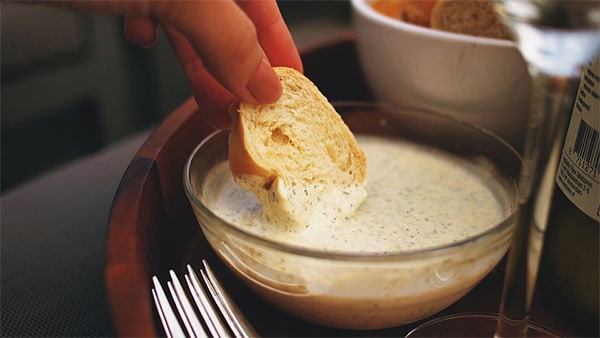As egg-based dressings go, mayonnaise is one of the most popular. With its widely-loved taste and versatility, it can be used as a condiment, a spread for sandwiches, a dressing, and even as a thickener or binder in cooking.
However, being that this dressing is made with eggs, it can spoil quickly even if you keep it refrigerated. In order to extend its shelf life and usage, you can freeze mayonnaise - but be aware that it is a strange process, and unlike most freezing methods you’re likely to be familiar with.
Keep in mind that mayonnaise is an emulsion, and so freezing it could cause the ingredients to separate. They could also break down, and you could be left with less than appealing results once defrosted.
But don’t worry - we’ve come across a method to help best maintain the original texture even after deep freezing.

This post may contain affiliate links. Read my disclosure policy here.
How do you freeze mayonnaise?
Though eggs by nature are very difficult to keep from spoiling, it is also the oils and vinegar (or lemon juice) found in mayonnaise that increases the speed of spoilage.
This is especially true the more times you open your jar of mayo. Therefore, if you do need to freeze your mayonnaise, make sure to do it as soon as possible.
The most important thing you need is freezer-safe sterilized glass bottles, and to ensure your bottle is sterilized you’ll need to submerge it in a pot of water and bring it to a boil for 5 minutes.
Next, you’ll need to take a clean spoon and scoop enough mayonnaise to fill the sterilized glass, leaving roughly an inch so that it has room to expand once frozen. Remove as much air from the glass as you possibly can, then firmly seal it and put it in to freeze.
Frozen mayonnaise should keep for 5-6 days. However, store-bought varieties will last longer than any you may have handmade, as the ingredients within will have been stabilized to extend the product’s life.
How do you defrost mayonnaise?
To defrost frozen mayonnaise, your best bet is to remove it from the freezer and place it on the bottom shelf of your fridge, leaving it there to allow the mayo to slowly soften.
Though your dressing may hold its form whilst frozen, thawing will cause it to break down. In most cases the oil will break first from the emulsion, leaving a top layer of liquid and leading to an unappetising appearance.
Of course, with their stabilized ingredients this won’t be as noticeable or extreme for store-bought mayonnaise.
In any case, you can either drain this excess fluid or perform a re-emulsion. To do so, pour the softened mixture into a mixing bowl and, using an electric mixer, briefly blend on a high speed. This should only need a few seconds.
You might find that the dressing won’t always emulsify immediately, and if this is the case then try adding the mayonnaise into the bowl one spoonful at a time instead.
Frequently Asked Questions
What is an emulsion dressing?
Emulsion dressings are those which are made by suspending liquids within each other that do not usually mix together.
As the liquids inside these dressings can not naturally blend, over time they will eventually separate.
In mayonnaise, these non-mixing agents are the vinegar/lemon juice and oils, which are often binded together by egg yolk.
Can I defrost mayonnaise in the microwave?
Mayonnaise requires a slow method to defrost, and so microwaving or other common re-heating methods aren’t recommended.
Even with the slow, fridge-based method we’ve listed above there’s a chance that the ingredients will separate, so if you increase the rate at which your dressing thaws then you increase the chance that the mix will break down and the product will spoil.
Can you freeze sauces that contain mayonnaise?
This depends on the sauce itself, and mainly its other ingredients. If the sauce contains any kind of dairy product, it’s better that you don’t freeze them purely because the mixture will spoil upon defrosting.
Dips, on the other hand, can be stored frozen for about a week.
Can you freeze mayonnaise that contains greens?
Again, it’s not recommended.
As we’ve said, the condiment tends to break upon defrosting, which gets more and more difficult to avoid or fix the more ingredients there are in the mixture.
Can you freeze dishes that contain mayonnaise?
In large part, this will come down to the suitability for the individual dish and its components for freezing.
For something like a casserole or a dish that has mayonnaise blended in (as opposed to used as a dressing), you can freeze it. However, you must be aware that upon defrosting, the dish may look different and have a different consistency to when you cooked it.
If that doesn’t bother you, then go ahead and freeze the dish. Airtight containers are your best bet here, as they’ll stop moisture from entering the dish which can go on to cause freezer burn and frost.
You’ll also need to leave some room inside the container for the dish to expand during the freezing process, and always remember to keep track of when you placed it in the freezer.
Can I use defrosted mayonnaise as a spread?
There’s nothing stopping you from doing so, but once again remember that the mayonnaise may behave differently once defrosted.
As the thawed mixture may be thinner or contain excess liquid, it obviously won’t behave the same once spread across bread, perhaps even causing it to sog.
If you love having a thick spread on your sandwiches, this probably isn’t something you should try.
Summary
In short, prepare yourself for a defrosted mayonnaise to be different to its original form.
Even after re-emuslifying it’s likely to have a thinner texture, and you should always consider what your planned usage for thawed mayo will be.
However, if there’s nothing about the potential aftereffects that raise any concerns, now you’ve got the knowledge of this guide to help you then you have all you need to properly freeze your mayonnaise!





